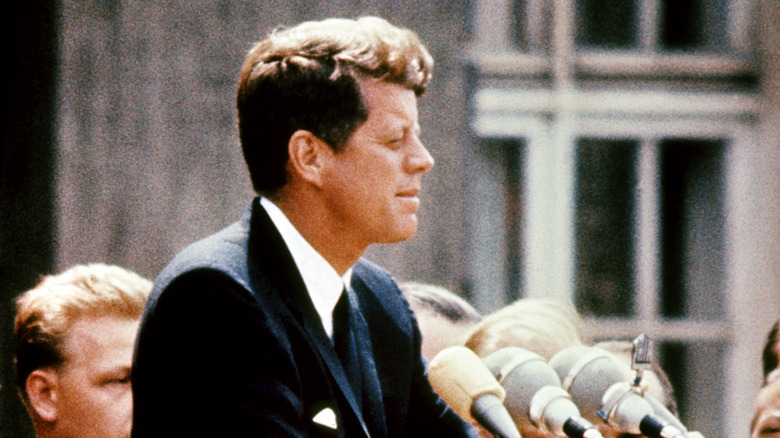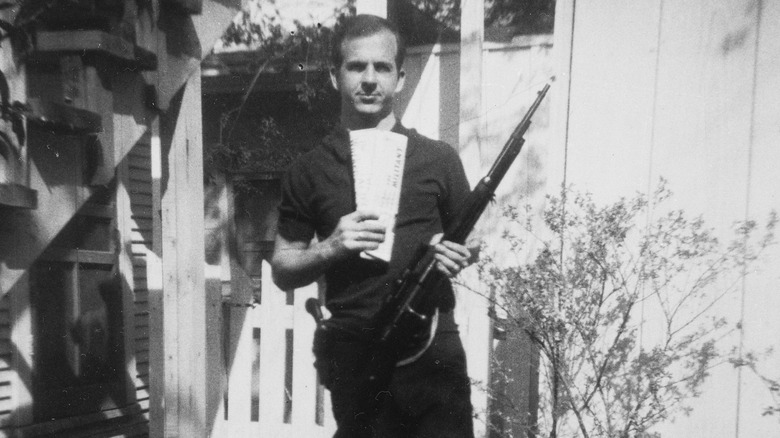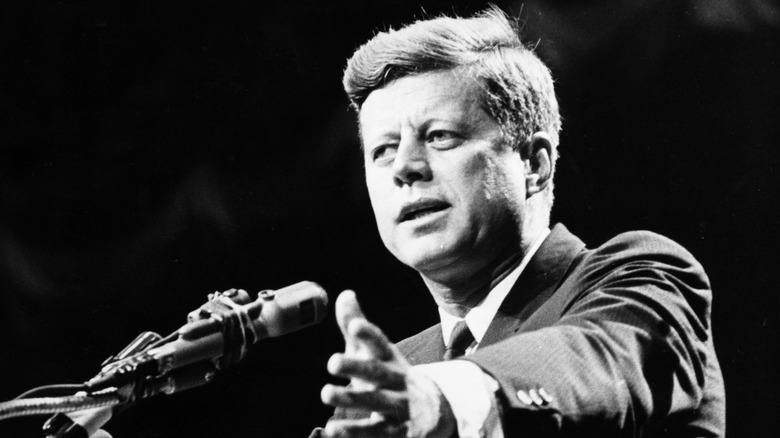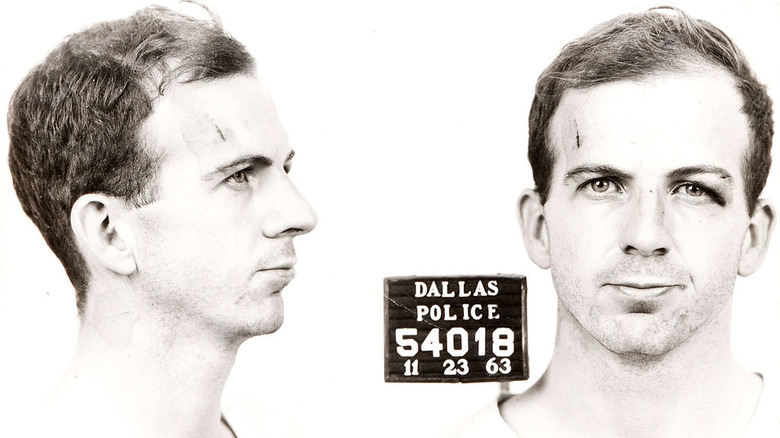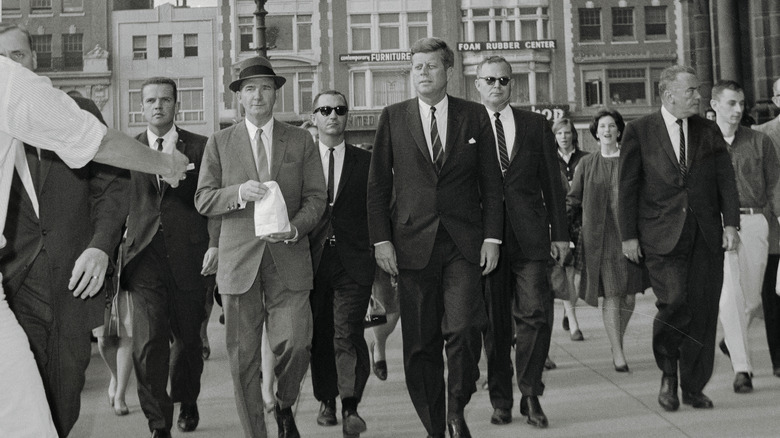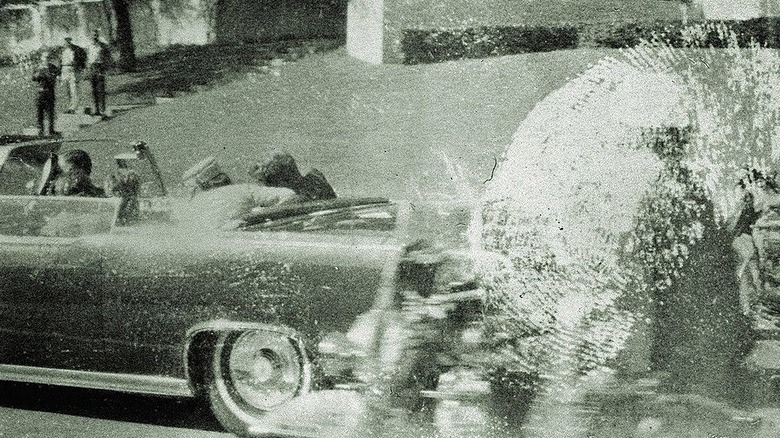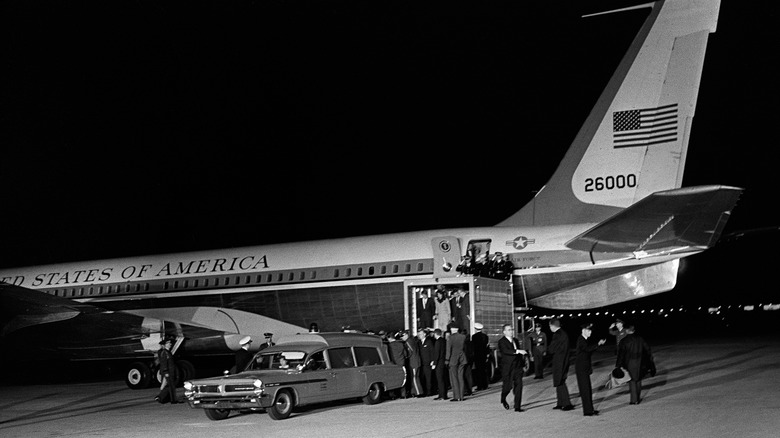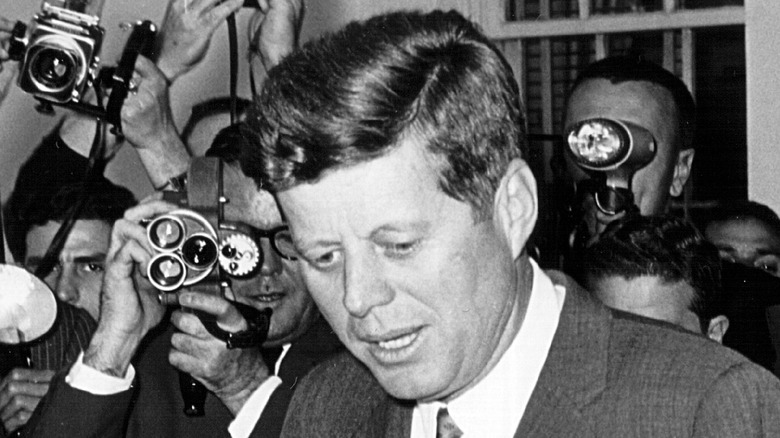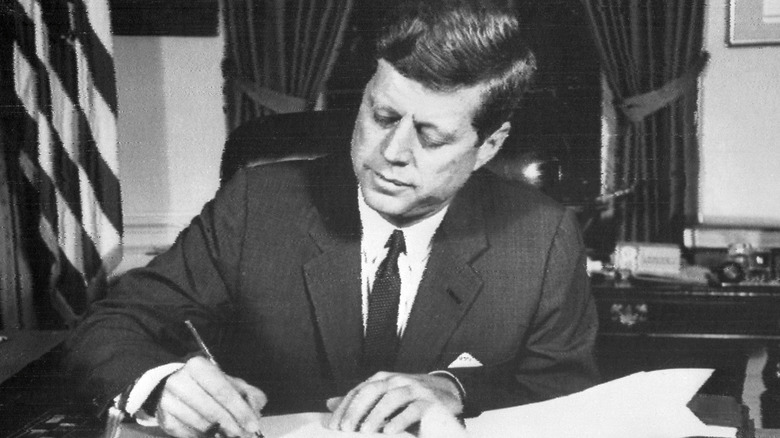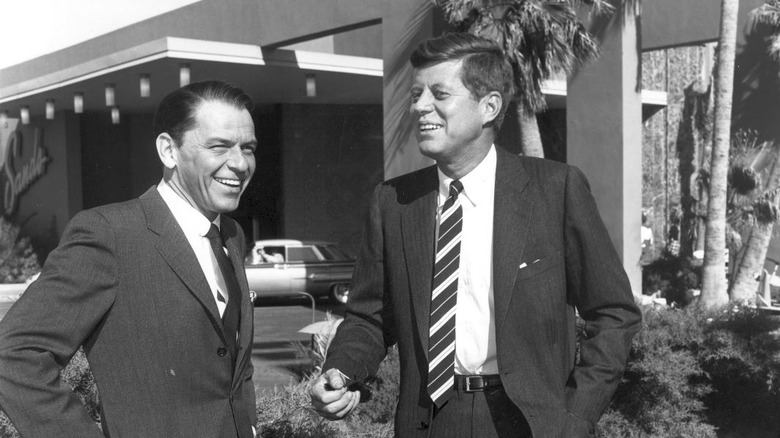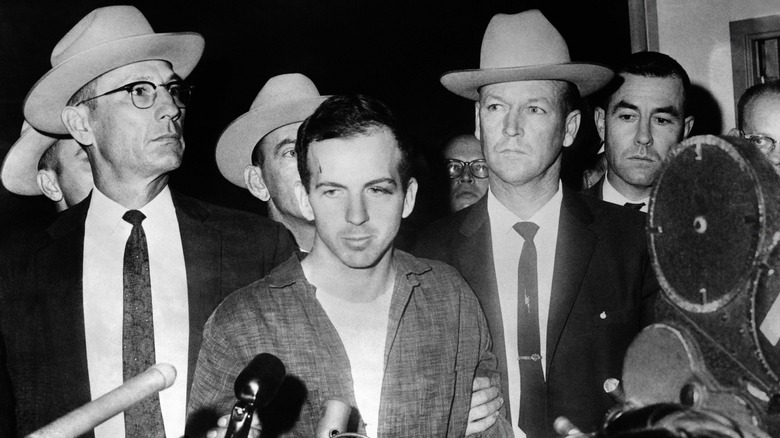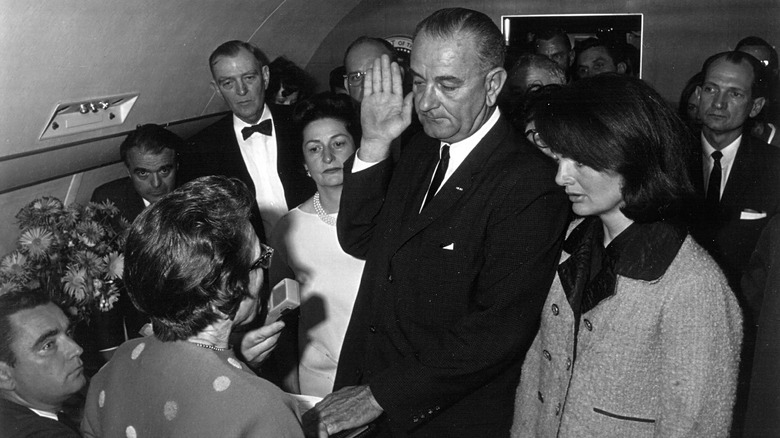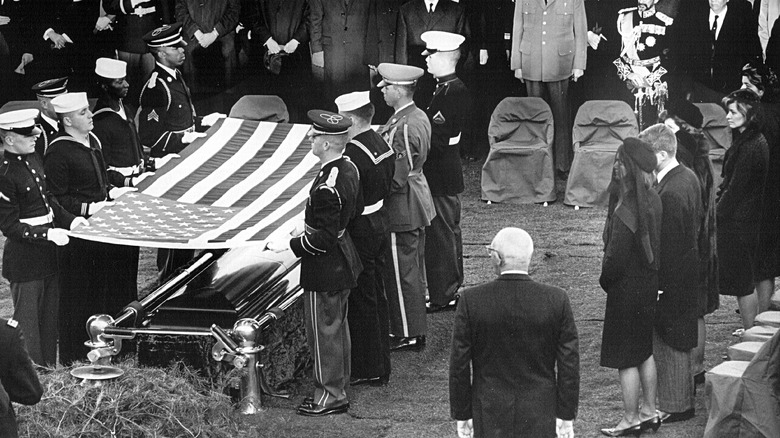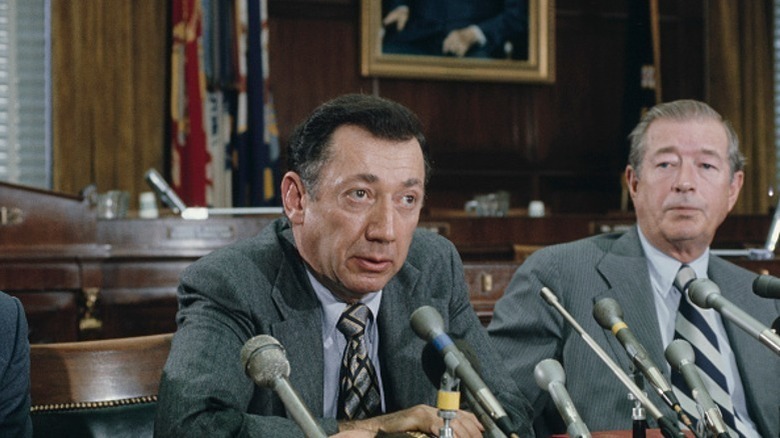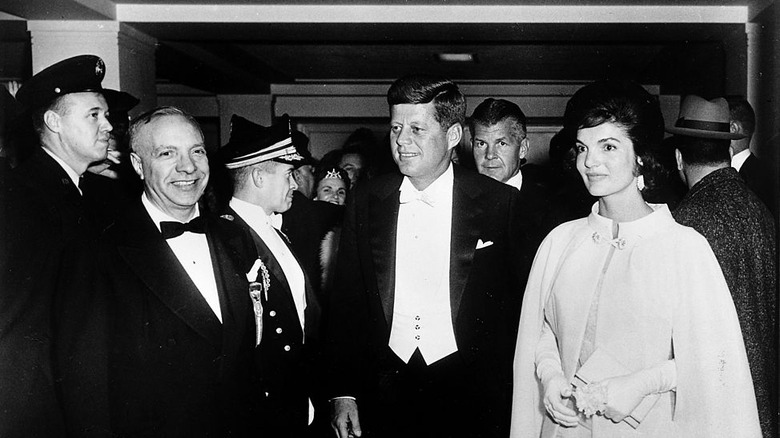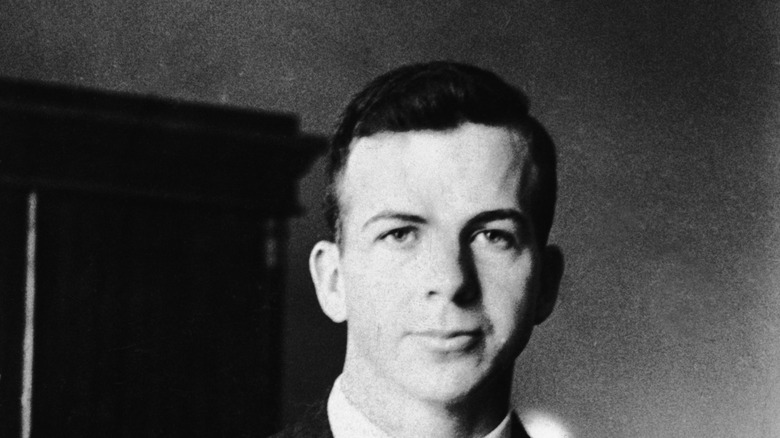Bizarre Things That Never Made Sense About JFK's Assassination
Four American presidents have been assassinated, but only one of their deaths still keeps many of us awake at night. When Lee Harvey Oswald squeezed the trigger on his rifle on November 22, 1963, he changed the Western world forever. Over 60 years later, we're still poring over the details of John F. Kennedy's murder with a passion even the Secret Service probably couldn't muster for the assassinations of William McKinley and James A. Garfield.
Yet despite the countless books, articles, and overly paranoid Oliver Stone movies, there's still plenty surrounding JFK's death that doesn't make sense — meaning it's crazier than a sackful of meth-addicted cats. We're not saying any of the following proves the CIA colluded with aliens and Elvis to assassinate the 35th president. But we are saying these facts are bizarre enough to make us wonder if what happened in Dallas that day will ever make sense.
Lee Harvey Oswald's mysterious Mexico City visit
When historians call Lee Harvey Oswald "enigmatic," they're severely underplaying just how mysterious a dude he was. There's a lot we don't know about the 20th century's most infamous assassin. We don't know why he did it, and we sure as heck don't know why he spent the weeks before the assassination hanging out in Mexico City. Mexico City in the '60s was to Cold War spies what Miami Beach is to spring break bros. As Professor T. Jeremy Gunn put it to NPR, the city was "the spy capital of the Western hemisphere." Cuban agents, Soviet moles, and CIA operatives all rubbed shoulders. That Oswald was among them raises all sorts of weird questions.
We do know Oswald partly used his time in Mexico to try and secure a Soviet visa. We don't know why the records of this are all screwed up. The day he visited the Soviet embassy just happened to be the day the CIA's camera broke, so we have no pictures. We once had a recording of a tapped phone call from a guy claiming to be Oswald, but J. Edgar Hoover decided it wasn't Oswald's voice, so the tape vanished.
That's before we get onto the random guys Oswald was with. According to Politico, CIA informers saw Oswald with two young Americans at a party in the city. We still haven't established their identities. All we know is they spent a few days hanging out with a soon-to-be presidential assassin and then vanished forever.
The June Cobb connection
One of the spies in Mexico City at the time of Lee Harvey Oswald's visit was June Cobb. An Oklahoma girl who turned pro-Castro revolutionary before becoming disgusted with Cuba and turning CIA spy, Cobb was a valuable intelligence asset. Her claims were usually taken seriously. So when she followed up Kennedy's assassination by telling her CIA handlers Oswald had been seen at a Mexico City party where people j about killing JFK, you better believe the feds listened.
The story comes via Politico, and we should say here that its specifics remain shrouded in mystery. Cobb's file is still under lock and key for security reasons, so Politico's reporting comes only from related CIA and FBI files. Still, it's fascinating reading. Mexican playwright Elena Garro reported the party to Cobb, saying it was a meeting place for Cuban diplomats. Some were even joking about how useful it'd be if Kennedy was killed. Garro's information was so shocking that the FBI interviewed her in 1964.
Cobb's intel was disparaged by the CIA, and no follow-up action seems to have been taken. No evidence connecting the assassination to Cuba or the Soviets has ever surfaced, even after the opening of files related to the KBG, the Soviet Union's secretive government security office. Still, it does make you wonder what exactly happened at that party and just what Oswald was doing there.
Oswald was never questioned by intelligence agencies
Perhaps the strangest thing about Lee Harvey Oswald is that he was under heavy surveillance by U.S. intelligence agencies after defecting and upon returning to the United States — so how was he not stopped? On October 16, 1959, he arrived in Moscow and wrote to the Soviet authorities, renouncing his American citizenship (you can read the note yourself at the National Security Archive's blog). When the Kremlin rejected Oswald's overtures, he tried to kill himself.
This desperate act was enough to bag Oswald a temporary stay in the USSR. The KGB shipped him out to Minsk and secured him work in a radio factory. According to Pulitzer Prize winning journalist Anthony Summers (via the Telegraph), Oswald wanted more than to just help make the best radios in Eastern Europe. Oswald later claimed he'd offered the Soviets information on America's U2 spy planes. For those keeping score, that would be the point his simple defection tipped over into Lando Calrissian levels of betrayal.
Flash forward to June 1962, and Oswald was back in the States, this time with a Soviet wife and newborn daughter. Given everything above, you'd probably expect his return to be announced by dozens of men in dark glasses bundling him out of the airport and into a mobile interrogation chamber. Yet, the CIA never questioned him. The FBI did question him twice after his return, and once again on August 10, 1963 after he was arrested for disturbing the peace by handing out pro-Castro flyers. For whatever reason, a defector was given free rein to waltz around the country, until he finally shot the president.
The Secret Service's weird inaction
Messing with the Secret Service is like inviting a gang of highly trained ninjas to go to town on your pathetic attempts at assassination. Just watch the video of Ronald Reagan getting shot. The first shot goes off, a split second passes, and then the president has been whisked away while John Hinckley Jr. has vanished beneath a sea of roiling bodies and fist-based justice. Now compare the Kennedy assassination. The first bullet hits JFK in the throat, and the Secret Service does ... nothing.
The second bullet is the headshot that killed Kennedy. Five seconds passed between the two shots. A high-speed Reagan-style response could've saved the president. Instead, as Vanity Fair details, the members of this elite unit sat on their backsides. Driver William Greer didn't take evasive action. Paul Landis, following the Kennedy car, didn't jump onboard and shield the president with his body. The Secret Service guy you see jumping onto the car in the assassination footage? That's Clint Hill, part of the first lady's detail, fulfilling his duty to protect Jackie.
Interviews with Secret Service personnel in the Vanity Fair article talk of a macho culture where members would refuse food and sleep and spend every night getting crazy drunk. While a no-sleep hangover would explain their inaction, it doesn't explain other weird screw-ups. Like why the running boards on JFK's car were retracted, meaning there was no one to protect the president if something happened. (Spoiler: Something happened.)
We still don't know who the Babushka Lady was
Following the assassination, law enforcement tried to trace all possible witnesses. This was an even bigger headache than you're probably imagining. Many were known only by nicknames, like Umbrella Man, the Three Tramps, or Badge Man. It took until the 1990s to track most down (or, in the case of Badge Man, prove they probably didn't exist). And guess what? The hunt ain't over. We still have no idea who the Babushka Lady was. Known for her Russian-style headscarf, the Babushka Lady was on Dealey Plaza and filmed the assassination. Such a piece of film would be of unimaginable historical importance.
People have been searching for her for decades. In 1970, a woman called Beverly Oliver even surfaced, claiming to be the mystery woman. Oliver also said she knew who "really" killed Martin Luther King Jr. and claimed she was recording JFK's death with a camera that hadn't been invented yet, so serious historians tend to dismiss her. Political science professor John McAdams has a point-by-point takedown of Oliver's claims on his Marquette University blog.
That means there's someone still out there who has unseen footage of a major historical event yet has never turned herself in, despite the endless publicity surrounding the assassination. If you're a headscarf-loving woman who was in Dealey Plaza on November 22, 1963, your local FBI office would love to hear from you.
There was a fight over who got to cut up the body
The bizarre aspects of the Kennedy assassination didn't end with JFK's actual death. If anything, things only got weirder. The body was taken to Dallas Parkland Memorial Hospital, but it barely got through the doors before a fight broke out over who got to slice and dice it.
The local coroner was a guy named Earl Rose. Since Kennedy was killed in Texas, he felt it was a state crime, that Texas law applied, and that he was responsible for the autopsy. As the LA Times recounts, the Secret Service and Jackie Kennedy felt Rose could kiss their behinds. Things quickly got ugly.
When Rose tried to physically block the Secret Service from the corpse, an understandably heated argument broke out about the legal niceties of the situation. At some point, Kennedy's detail decided "eh, screw it" and simply grabbed the body. According to some tellings, like this one from the Future of Freedom Foundation, guns were even drawn. Either way, the outcome was the same — Kennedy's corpse was hauled away (pictured above) to the Bethesda Naval Hospital, Maryland. Perhaps as a result of this fracas, there's no longer any ambiguity when a president is shot. A 1965 code makes it clear that attempting to assassinate the commander in chief is indeed a federal crime.
The inconsistencies and screwups with JFK's autopsy
Given how bright the spotlight was, you might expect the autopsy was (eventually) done with the utmost diligence. Ah, but if it had been, you wouldn't be reading about it now. Not only were parts of the autopsy done in a screwy way, but a whole lot of crazy issues also later surfaced (via NPR).
When you're cutting up a body, there are certain procedures you should follow. Removing and weighing the organs is one, something autopsy doctor James Joseph Humes admitted in 1996 he hadn't been done. This pales in comparison to the other things Humes didn't do. He didn't preserve the original JFK autopsy report. He made a handwritten copy then burned the original, an action about as unprofessional as deciding to present his findings through interpretive dance. Humes claimed he wanted to stop the bloodstained report becoming a source of morbid fascination. Intriguingly, he failed to destroy at least one other bloodstained document.
Then there are the autopsy photos. The ones in the National Archive are of low quality and seem to miss important details like the number of bullet wounds. When T. Jeremy Gunn showed them to the woman who had developed them, Sandra Spencer, as part of his work on the 1992 Assassination Records Review Board, she said they didn't look like the images she remembered processing. So Gunn tried to match them to photos printed by Spencer's lab shortly before the assassination. The photo paper types were completely different, suggesting they came from a different printing session.
The mysterious Cuba connections
It sometimes seems the only thing that could shed more light on what happened in Dealey Plaza that day is a deathbed confession from a professional assassin. Well, buckle up, because that deathbed confession already exists. In 1966, Herminio Diaz Garcia, a hitman for the Cuban mafia, died during a raid on a prison. Before he expired, he told fellow mobster Tony Cuesta a secret: He said he'd been responsible for the death of the U.S. president.
That's the story investigative journalist Anthony Summers tells in his book on the assassination, "Not in Your Lifetime." In 2007, Summers and Robert Blakey — a former chief counsel to the House Select Committee on Assassinations — interviewed Cuban exile Reinaldo Martinez Gomez. Gomez said he'd previously shared a cell with Cuesta, who told him about Diaz's confession. Summers claims it's a fact that Diaz was in the United States on November 23, 1963, and had previously carried out as many as 20 political assassinations.
This is just one man's word, and men often lie. But there are other bizarre connections to Cuba surrounding JFK's death. Also in 2007, former Kennedy detail Secret Serviceman Abraham Bolden told ABC about a tip-off the Service received ahead of JFK's aborted trip to Chicago on November 2, 1963. Two Cuban men had been spotted with rifles in a rented room along the motorcade route. Unfortunately, the surveillance operation against them was bungled, and the potential assassins vanished into the night.
The weird Kennedy-Giancana connection
It's hard to think of two people less alike than JFK and Sam Giancana. One was a beloved president, the other was a violent mobster who once worked for Al Capone. Yet if you were to write books on the lives of both Kennedy and Giancana, you'd find each kept cropping up in the other's story.
The coincidences add fuel to the conspiracy fires that the mafia killed Kennedy for riding hard on them, a theory floated by none other than our old friend from the House assassination committee, Robert Blakey. Giancana had ties to JFK's dad, Joseph P. Kennedy, from Prohibition, when both men were involved in bootlegging. And the ties may have gone deeper. In 1997, reporter Seymour Hersh wrote in his book "The Dark Side of Camelot" that Joseph P. Kennedy asked Giancana to help his son win the 1960 election.
Then there's Frank Sinatra. Both JFK and Giancana were friends of Ol' Blue Eyes (pictured). Frank's daughter, Tina, would later claim her father asked Giancana to lean on the unions to help JFK win the Democratic primaries. Both JFK and Giancana also shared a mistress, Judith Campbell Exner, who said in 1988 that she had arranged secret meetings between them.
The strangest part of all may concern not Kennedy's death, but Giancana's. The mob boss was used by the CIA to attempt a hit on Castro. But just before he could testify before the Senate's Church Committee about his work with the agency, Giancana himself was assassinated.
The fiasco surrounding Oswald's police interview
You've watched detective dramas of varying quality. What's the one thing cops always do when interviewing suspects? That's right, they record everything they're saying. Well, what's good enough for two-bit criminals apparently ain't good enough for the guy who just assassinated the president. There are almost no official notes of the Dallas police or the FBI's questioning of Lee Harvey Oswald. As the New York Times details, the interrogators didn't use a tape recorder and had no stenographers present to take accurate notes.
Records of the interrogation of the 20th century's most notorious assassin come solely in the form of handwritten notes made by the two interviewers. These notes are themselves rough and incomplete, offering only the tiniest glimpse inside Oswald's dangerous psyche. If we had more detailed notes, it's possible that we'd understand him and his motives much better than we do now. Incredibly, we only have one set of these notes today because they were discovered among the personal belongings of former Police Captain J.W. Fritz in the 1990s and anonymously donated.
The notes are very clear on one thing, though: Oswald repeatedly protested his innocence. Perhaps most interestingly, claimed that the images of him posing with the rifle used to kill Kennedy were faked. Ignoring the conspiracy implications, it at least suggests Oswald's motive wasn't fame or notoriety.
A whole bunch of official records were destroyed
Remember the burned autopsy report? It wasn't the only official record that got destroyed. In the years since John F. Kennedy's death, a whole bunch of records and important documents have vanished into history's incinerator. The Mary Ferrell Foundation maintains an online database of official notes regarding the missing records. While many of the foundation's conspiracy theory claims are unsupported, the missing records are well-cataloged.
Among the documents missing are a note written by Lee Harvey Oswald and sent to the FBI, an Army Intelligence file on Oswald, and Secret Service records relating to a trip JFK nearly took to Chicago in November 1963. In addition, there's some evidence the Marine Corps, of which Oswald had been a member, launched its own investigation after the assassination, but no documents from it have ever surfaced.
Perhaps even kookier is the story of the missing page from Oswald's notebook, reported in the LA Times. Historian and journalist James Reston Jr. claims Secret Service agent Mike Howard checked Oswald's apartment after the assassination and found a notebook with a page headed "I WILL KILL." Underneath were the names of an FBI agent, a general, and Richard Nixon. Texas Governor John Connally was also listed with a dagger drawn through his name.
Reston views this as more evidence that Oswald meant to kill Connally, who was riding in JFK's car and badly injured in the assassination. Whether his interpretation is correct or not is a moot point. The page was torn out after Howard handed the book over and has been missing ever since.
The president's brain vanished
It may sound like a Troy McClure movie, but this is no joke. President Kennedy's brain did indeed go missing. In 1966, it was revealed to have vanished from a secure room at the National Archives. If you think that's weird, buckle up. Award-winning historian James L. Swanson wrote in his book "End of Days: The Assassination of John F. Kennedy" (recounted here by Vanity Fair) that he believed the thief was Robert F. Kennedy.
After Kennedy's autopsy, his brain was placed in a stainless-steel container. It was kept on file along with several samples of brain tissue, first by the Secret Service, then at the National Archives. Being both important and utterly morbid, its time at the archives was spent under the watchful eye of JFK's old secretary. That makes its disappearance all the more mystifying. In October 1966, someone went looking for the brain and found both it and all its tissue samples had vanished. The Attorney General immediately ordered an investigation. Half a century later, we're still waiting for it to turn up.
So where does RFK fit in? Swanson's theory is that Kennedy's brother stole his brain to cover up the massive stew of drugs the president was taking. According to the Telegraph, JFK was knocking back codeine, Demerol, and methadone for his back pain, along with a galaxy of other pills for insomnia and anxiety.
One investigation said Kennedy was killed by a conspiracy
Have you ever wondered why so many Americans (65 percent in 2023, according to Gallup) believe the nutjob conspiracy theories surrounding JFK's death? Well, a large part of that might have to do with the House Select Committee on Assassinations. Established in 1976 to look into both the JFK and MLK shootings, the HSCA examined scientific evidence and witness statements before coming to the following conclusion (via the National Archives): "The committee believes, on the basis of the evidence available to it, that President John F. Kennedy was probably assassinated as a result of a conspiracy." Yikes.
Okay, some clarification. The HSCA specifically ruled out Cuban, Soviet, anti-Castro, mob, FBI, CIA, or Secret Service involvement, although it totally flamed the Feds for not taking the idea of a conspiracy seriously. It also declined to comment on the extent of the conspiracy, concluding merely that the evidence suggested a second gunman was involved. Still, you can imagine how the great American public reacted to that above quote. The answer isn't "calmly."
It's important to note some of the HSCA's findings have since been debunked. One major plank in the conspiracy claim was scientific analysis of a sound recording that suggested four shots had been fired. The HSCA used echoes to establish one of these came from the grassy knoll. The National Academy of Sciences later determined this analysis was flawed, that not all the sounds were gunshots, and that the sounds that were gunshots didn't come from the knoll anyway.
The CIA's private disbelief in its own public conclusions
In July 2017, a handful of new files on JFK's death were released to the public. This was in accordance with a 1992 law that all records of the assassination must be declassified by October 26. While most of the new files were little more than duplicates of already public material, they did contain one strange new nugget of information.
From the Warren Commission onward, the CIA had publicly embraced the lone gunman theory that Lee Harvey Oswald acted alone. By the mid-1970s, the new documents revealed, the CIA no longer believed this. Internally, the agency began to consider JFK's death part of a possible conspiracy, even as they continued to publicly support the theory that Oswald acted alone.
What the CIA believed happened is vague and sometimes contradictory. Some agents seem to have started taking the Soviets and Cuba seriously as suspects. Others seem to have worried the killing was inadvertently related to their own work. This theory went that Oswald read about CIA assassination attempts on Castro and killed Kennedy in revenge. As Politico notes, "If that proved true, it would have raised a terrible question for the CIA: Was it possible that JFK's assassination was ... blowback for the spy agency's plots to kill Castro?" Whatever was really happening inside the agency, the CIA outwardly kept its worries private, even from other government agencies. Why it may have felt the need to do so is just one more oddity on the JFK pile of unexplained weirdness.
The man who shot JFK wasn't very good at shooting
After the fall of the Soviet Union, the KGB files were briefly opened to researchers. Among them was file no. 31451, detailing Lee Harvey Oswald's time in the USSR. Before the files were closed again, Russian paper Izvestia reported on some of its contents in 1991 (via Independent). Rather than add clarity, the reports only further muddied the conspiracy waters.
As a defector, Oswald was of considerable interest to the KGB. Yet the files reveal the Kremlin effectively thought he was useless — the KGB believed Oswald incapable of pulling off Kennedy's assassination. After President Donald Trump issued an executive order in 2025 to release all remaining files without redaction, those materials began to be released to the public, and they supported this 1991 reporting. One declassified report provided some context about the man who would eventually shoot and kill a public figure in a moving car from a significant height and distance — Oswald apparently wasn't a notably skilled gun operator.
In the late 1950s, Oswald decamped to the Soviet Union, and the secretive government security office, the KGB, kept an eye on him. In a transmission dated November 20, 1991, a KGB agent named Slava Nikonov told American college professor E.B. Smith that he'd studied five expansive KFG files on observations of Oswald. It was of the opinion of the KGB that Oswald lacked the psychological profile that would've made him a useful asset, as well as the shooting skills. Agents watched Oswald when he took target practice, and they weren't impressed with his lackluster shot.
